You guys know that I love my bowl meals, right?? They have everything you need in one bowl, with more flavor, texture, and color than you can shake a stick at. But the more I make bowl meals the more they resemble Bibimbap, the mother of all bowl meals. If you haven’t yet discovered the awesomeness of bibimbap, read on to get all the details. While my bibimbap is not authentic, I was able to use what I had on hand to make something similar enough to kick that craving.
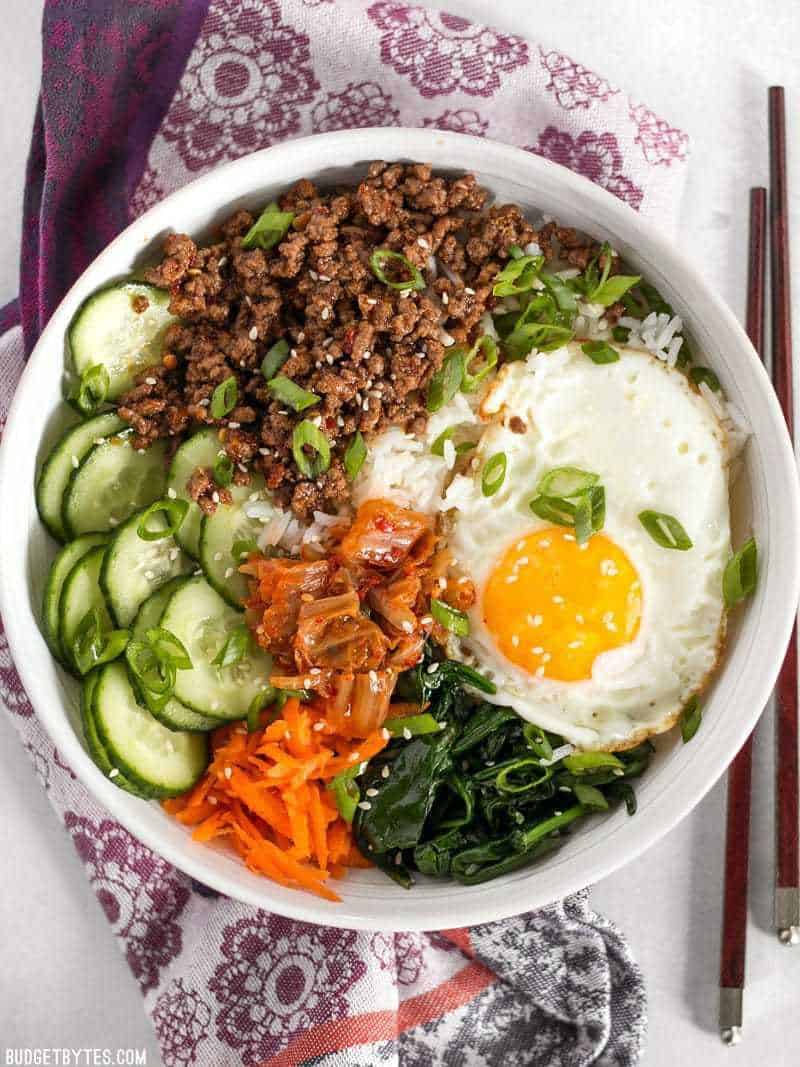
This post contains some affiliate links, which means that we make a small commission off items you purchase at no additional cost to you.
What is Bibimbap?
If you’ve never heard of Bibimbap, it’s a Korean dish that combines rice, seasoned vegetables, meat, egg, and a variety of other toppings. The awesome concoction is cooked in a stone bowl so the bottom gets deliciously crispy, adding even more color and texture to the meal. It’s truly the best bowl meal around.
Try These Authentic Bibimbap Recipes
Because I didn’t have all the ingredients and tools that traditionally go into bibimbap, I want to provide you some links to real bibimbap recipes so you can see what it in all its glory. Check out these traditional bibimbap recipes:
My Interpretation
As I mentioned above, I didn’t have all the ingredients or tools that are usually used for bibimbap, so I had to get a little creative. I didn’t have a stone bowl, so I had to sacrifice that crispy rice bottom. 😭 Also, I didn’t have any gochujang, so unfortunately I didn’t have that wonderfully salty-spicy-sweet sauce to go on top. I ended up adding some kimchi, which is not usually served on bibimbap, but it was still delicious.
Make Your Bibimbap Your Own
This dish is totally flexible and you can add or remove ingredients as you see fit. Pickled vegetables are fantastic in bibimbap, so if you want to take a few extra minutes to pickle your carrots or cucumbers, you won’t be sorry. You can find directions on how to pickle carrots here, and you can use this cucumber salad as a guide for the cucumbers.
While it looks like there is a lot going on in this bowl, I promise it’s super quick and easy. If I hadn’t been stopping to take photos every few minutes I probably could have finished prepping the ingredients for the bowls in about 30 minutes!
Meal Prep it!
Bibimbap is perfect for meal prepping. Simply pack up about four bowls at a time in resealable containers and refrigerate the grab-and-go lunches. You can either fry up an egg fresh each day, or substitute the runny-yolk fried egg with a hard boiled egg.
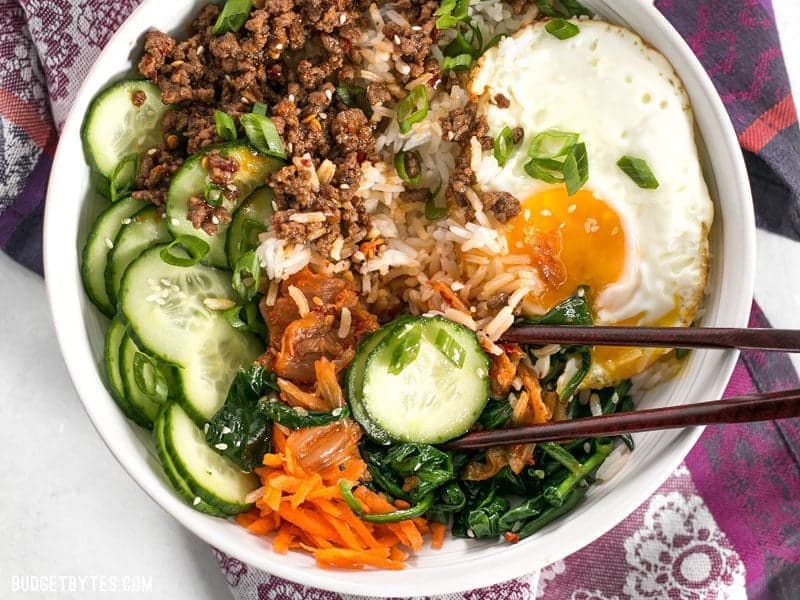
Love bowl meals? Check out our Bowl Meal category for more easy one-bowl meals that work great for meal prep!
Bibimbap – The Ultimate Bowl Meal
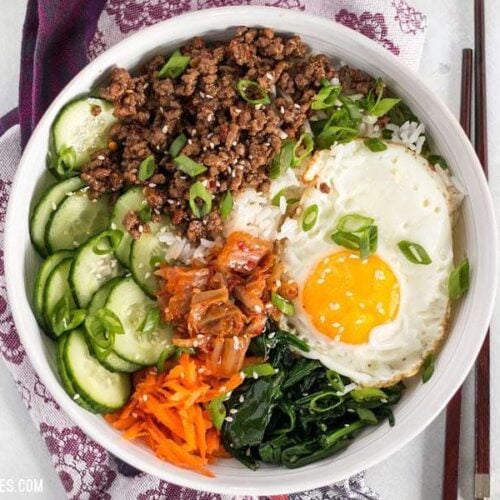
Ingredients
RICE
- 4 cups cooked jasmine rice ($0.75)
SAUTEED SPINACH
- 1/2 Tbsp cooking oil ($0.02)
- 6 cups fresh spinach, loosely packed ($1.72)
- 1 tsp toasted sesame oil ($0.11)
- Pinch of salt ($0.02)
CHILI GARLIC BEEF
- 1/2 lb ground beef ($1.99)
- 2 Tbsp chili garlic sauce ($0.13)
- 1 Tbsp soy sauce ($0.09)
- 1 Tbsp brown sugar ($0.04)
FRESH VEGETABLES
- 1 carrot ($0.11)
- 1 cucumber ($1.69)
- 2 green onions ($0.21)
OTHER TOPPERS
- 4 large eggs ($1.08)
- 1/4 cup kimchi ($0.82)
- 1 Tbsp sesame seeds ($0.08)
Instructions
- If your rice is not already cooked, begin that first and prepare the rest of the bowl ingredients as the rice cooks. You’ll need 4 cups cooked rice.
- Prepare the sautéed spinach next. Heat a large skillet over medium flame and add the cooking oil. Swirl to coat the skillet, then add the fresh spinach. Sauté the spinach for a few minutes, or just until it is wilted. Drizzle the sesame oil over top and season lightly with a pinch of salt. Remove the spinach from the skillet to a clean bowl.
- Add the ground beef to the skillet used to cook the spinach. Cook the beef until fully browned, then add the chili garlic sauce, soy sauce, and brown sugar. Stir and cook for about one minute, or until everything is evenly mixed and the beef is coated in sauce. Turn the heat off.
- Prepare the fresh vegetables. Peel and grate the carrot using a large holed cheese grater. Thinly slice the cucumber, and slice the green onions.
- Fry or soft boil 4 large eggs (Or however many bowls you plan on eating immediately. If meal prepping, cook the egg fresh each day.)
- Build the bowls by first adding 1 cup cooked rice to the bowl, followed by 1/4 of the cooked spinach, 1/4 of the ground beef, some sliced cucumber, shredded carrots, a cooked egg, an a tablespoon or so of kimchi. Sprinkle sliced green onions and sesame seeds over top. There are no hard measurements needed for each ingredient per bowl, just divide the ingredients evenly or as you see fit.
See how we calculate recipe costs here.
Nutrition
Scroll down for the step by step photos!
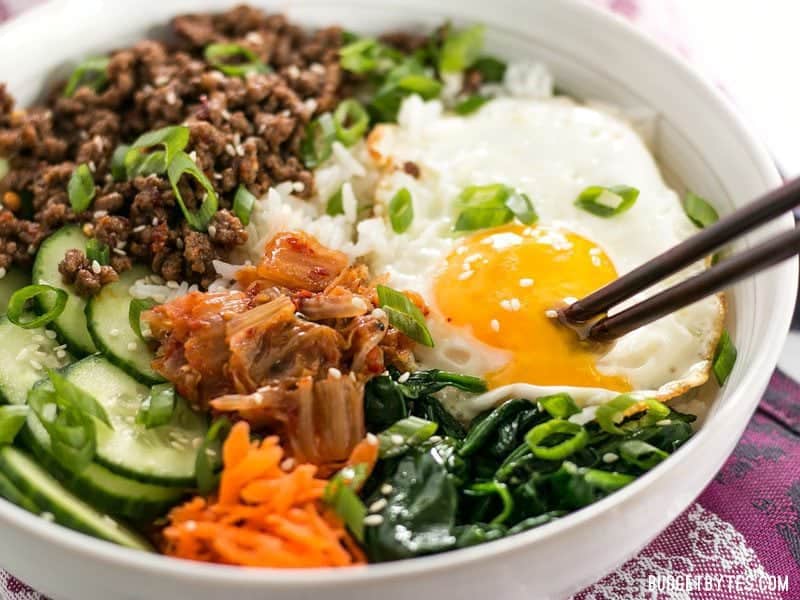
Bowl meals are so great because every bite gives you a unique mix with a little of this or a little of that. No two bites are the same!
How to Make Bibimbap – Step by Step Photos
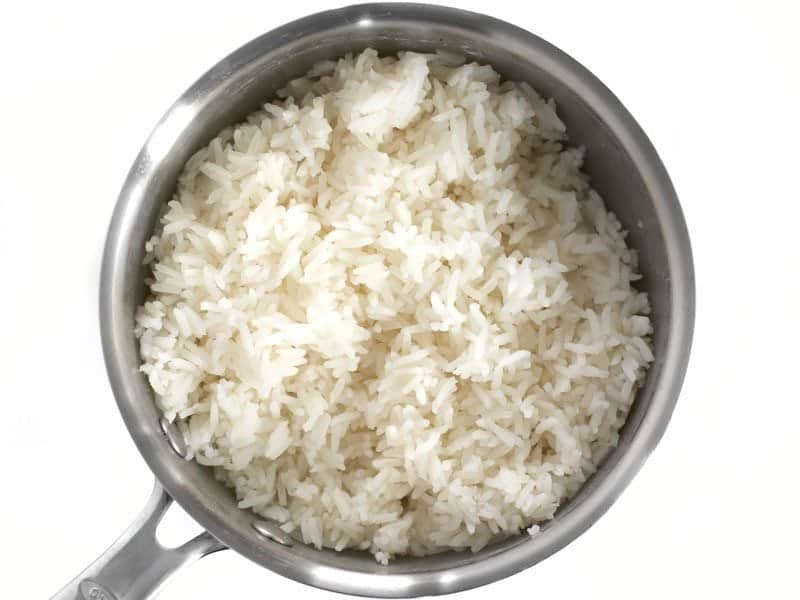
Cook your jasmine rice first so that it can you can prepare the rest of the ingredients as it cooks. You’ll need four cups of cooked jasmine rice.
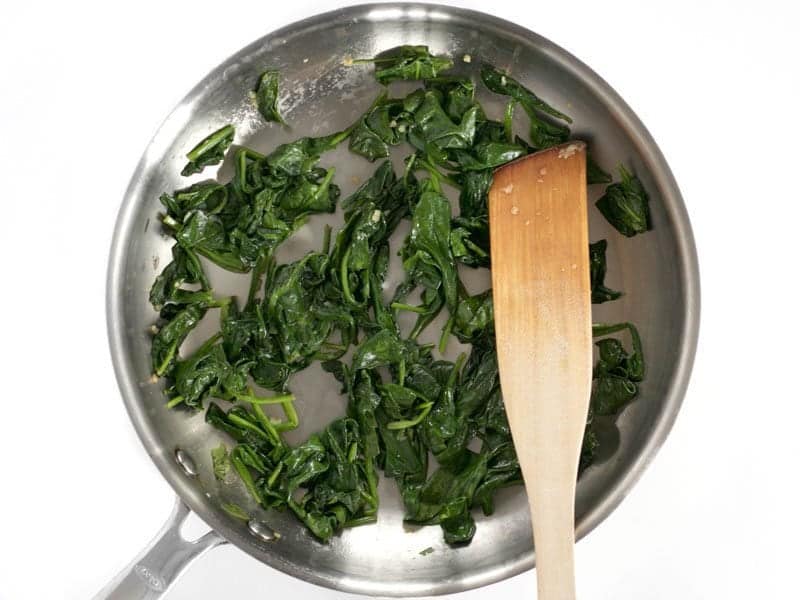
Add 1/2 Tbsp cooking oil to a large skillet and heat it over a medium flame. Add 6 cups of loosely packed spinach and sauté just until it’s wilted (this only takes 2-3 minutes). Once wilted sprinkle 1 tsp toasted sesame oil over top along with a pinch of salt. Stir to combine.
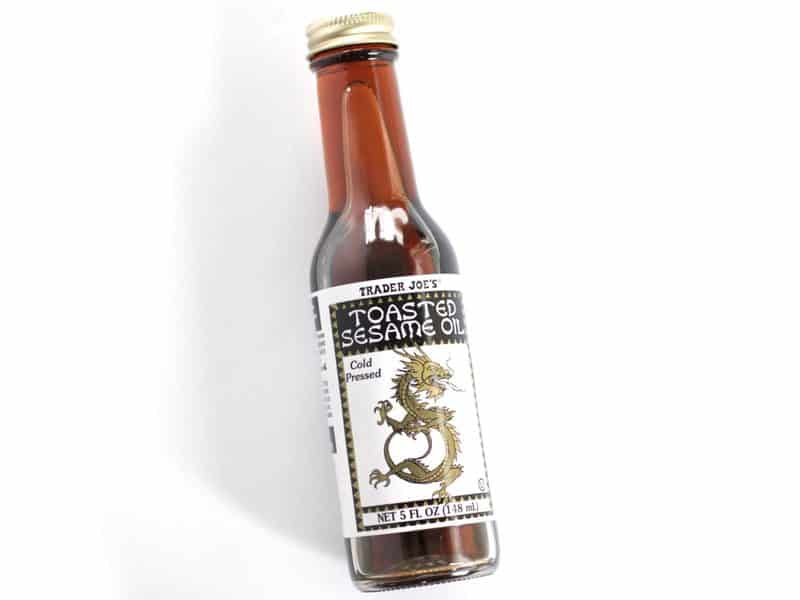
This is the ingredient that I get the most questions about, so I want to show it here. This is toasted sesame oil, which is made from sesame seeds that have been toasted before pressing. Toasting the seeds gives them a super strong nutty flavor. It’s best to be used as a finishing oil (after cooking) and a little bit goes a long way. Some brands don’t specifically say “toasted” on the label, but you can tell it’s toasted by it’s darker brown color and it’s usually sold in a very small bottle. Regular sesame oil (untoasted) is less expensive, usually comes in larger bottles, and is a light straw color. You can usually find this in the International food aisle of major grocery stores and I’ve found great prices at Whole Foods (365 brand) and Trader Joe’s.
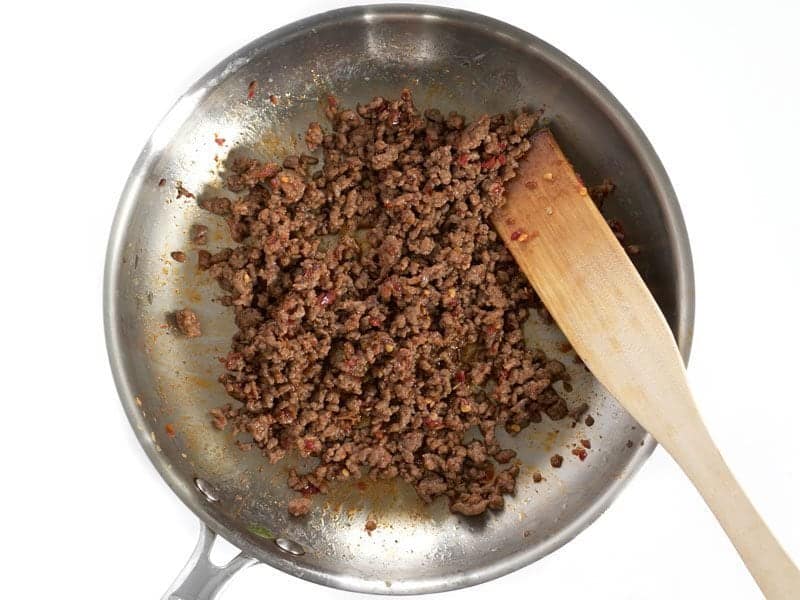
Remove the spinach from the skillet and add 1/2 lb. ground beef. My skillet still had enough residual oil from the spinach that I didn’t need to add any more for the beef (WIN). Cook the beef until fully browned, then add 2 Tbsp chili garlic sauce, 1 Tbsp soy sauce, and 1 Tbsp brown sugar. Stir and cook for 1-2 minutes more, or until everything is well mixed and heated through. Remove the beef from the heat.
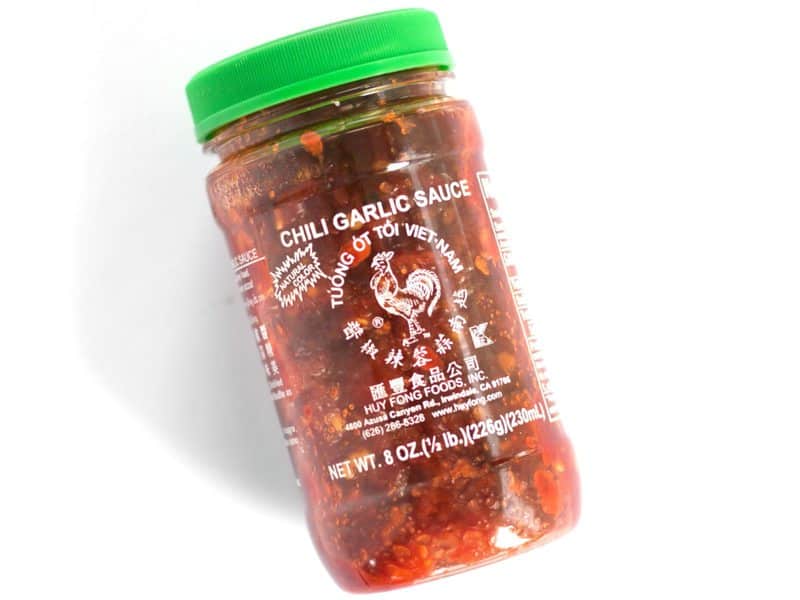
This is the chili garlic sauce I used. It’s super inexpensive and can be used in a lot of sauces and marinades. It’s basically just a chunky mix of red chiles, garlic, and vinegar. You can also use sambal, or in a pinch Sriracha.
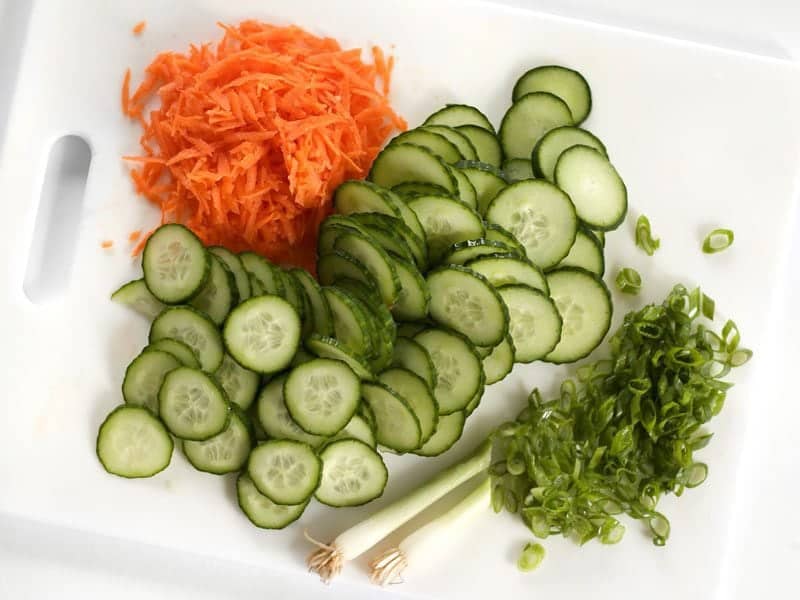
Finally, prepare the fresh vegetables. Peel and shred one carrot (I use a large-holed cheese grater). Slice one cucumber, and slice two green onions. Make sure to slice those cucumbers very thin. You can cook your egg(s) while you do this. I suggest either frying or soft boiling so that you have a nice runny yolk.
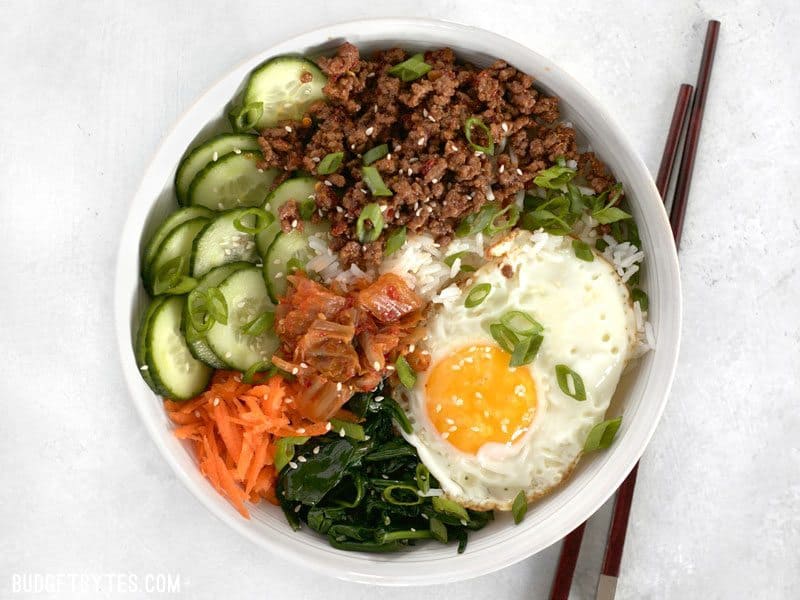
And then just throw everything together in a bowl! There is no hard or fast rule for proportions of the ingredients, just divide them up evenly or however it works for you. Start with a cup of rice, then 1/4 of the beef, 1/4 of the spinach, some of the shredded carrots, some sliced cucumber, about 1 Tbsp kimchi, and your egg. Then just sprinkle some green onions and sesame seeds over top and you’re done!
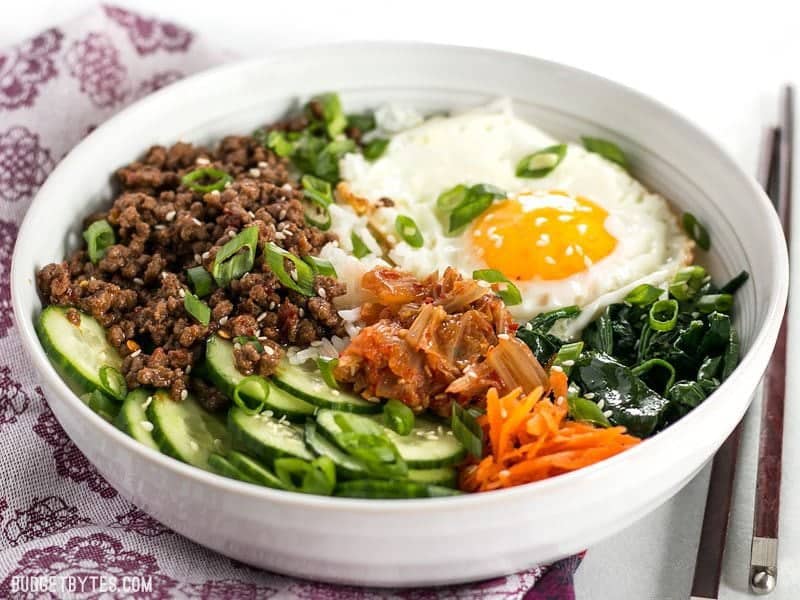
Seriously. Best. Meal. Ever.


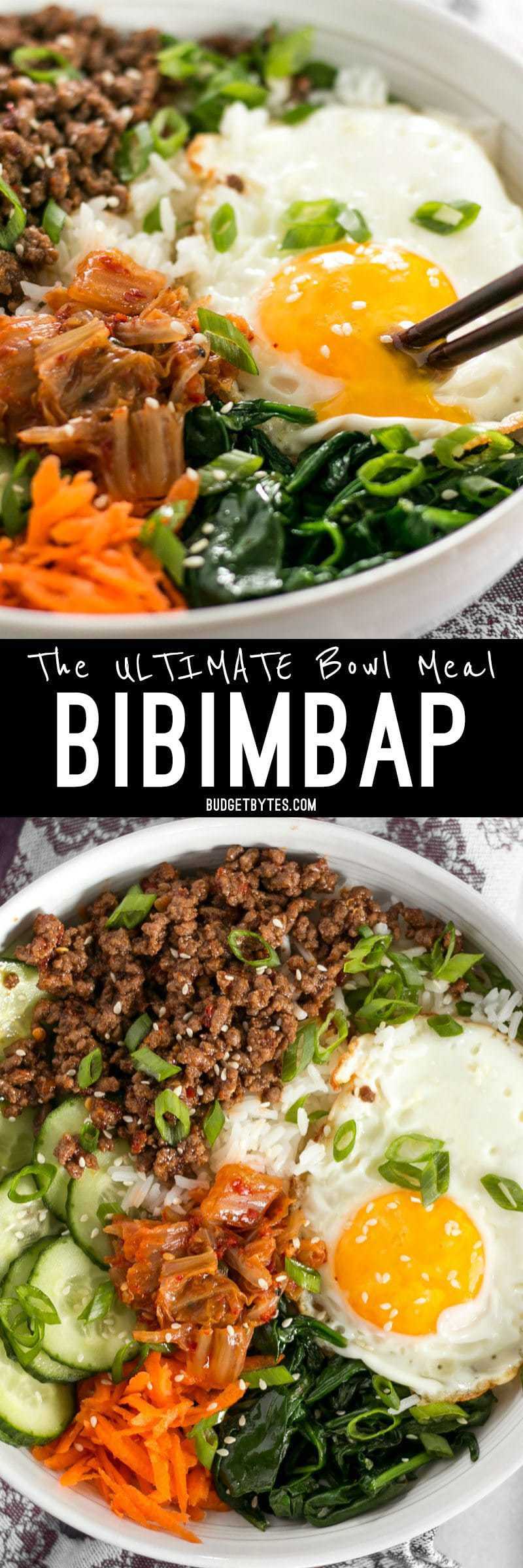
This was very satisfying! I love eating bibimbap at Korean restaurants (my favorite is in a hot stone bowl) but this was a good substitute that I could make myself.
Only change that is highly suggested is to add gochujang sauce. I bought some at my local not fancy grocery store, they had it in the asian food section. This sauce is red chili paste and it is savory and sweet and the perfect addition.
You forgot the gochuchang. It’s not bibimbap if there is no gochu. Try it in either the stone bowls or lodge has 9 inch woks. The rice gets nice and crispy.
You should eat it with a spoon. I’ve never seen people eating Bibimbap with chopsticks.
This may not be completely relevant because of the other hot ingredients and since it’s not typically Asian, but spinach works extremely well with walnut oil. I’d use that if toasted sesame oil isn’t available.
If you put a lid on the pan while frying the eggs they should get some cooked egg white over the yolks, just like they’ll have in your fav. Asian restaurant.
What is Kimchi? What other sauce could I use that I might have on hand. I have 4 of those 9″ pans.
Kimchi is a fermented cabbage condiment. It’s optional, so you don’t have to replace it with anything, but any type of chili garlic sauce would also be good.
This was awesome!
I made a few alterations: served this over rice noodles instead of rice, and used TVP in place of the ground beef, since my fiancee is (mostly) vegetarian. I rehydrated 1 cup TVP in 1 cup beef broth–like I said, mostly vegetarian–with a splash of liquid smoke and a small shake of MSG, and sauteed it for a little before adding the chili sauce, soy sauce, and sugar. The bowls were an awesome mix of tastes and textures, and I’m sure we’ll make this recipe again!
Nice! I was just eyeing this and going to use TVP also. Thanks for the recipe you used.
I’ve been inspired by your meal prep posts, so I thought I’d try and adapt this recipe to meal prep for the week. Almost identical, but no kimchi (since we couldn’t get ahold of any) and double the beef to make up for no egg (since I didn’t think they would last well in the fridge).
I just finished the first one for lunch today, and good grief is it delicious! What a wonderful meal.
This recipe was so amazing. I wasn’t sure how the ground beef was going taste, instead of the traditional beef in Bibimbap but I loved it!! Going to add this meal to my rotation.
I highly recommend using Gochujang (a red pepper paste) for the beef! It’s amazing too.
I didn’t have the same sauce as Beth so I eyeballed an analogous amount of gochujang instead. SO GOOD.
This recipe is SO GOOD. It is definitely in my top five favorites from your site, and that is saying something. LoL I had never tried kimchi before, but I found some in a jar at Walmart, and I am in LOVE. I could eat this every day for the rest of my life. Thanks for this one! <3
Please for the love of god get kimchii from a proper korean market.
For such a simple sauce, it is amazing how tasty and filling this meal this is. The soft cooked egg adds so very much texture and flavour.
This, and your other recipes, have helped us to reduce our monthly food budget, increase our vegetable intake, and improve our overall eating habits.
Thank you so much.
Thanks for the Korean joy! I’d strongly suggest a fast brine of the cucumber using the Momofuku cucumber recipe (search). I think it is critical to have the Kochujang sauce to give it some kick; it adds cost, but lasts forever and works on many dishes.
Thank you so much for this recipe! I had only had Bibimbap one other time (from a food truck) and I loved it, but I live in a pretty red-neck kind of town so it’s not something that we regular access to. My family was skeptical about the kimchi (found it in the organic section of our grocery store) and the fried eggs on top, but they all went to town on it! My four year old especially loved it… he wasn’t even halfway through his dinner and he was asking for me to make it again! I know in the future I won’t be quite so careful with the chili paste and the kimchi (I wasn’t sure how hot they would be together, so I took it easy). This is a wonderful addition to my recipe rotation.
I just stuffed my face with this and it is so good! I used rice noodles because I was not waiting for the brown rice I have in my pantry to cook. That made chopsticks a little difficult to use, but it worked! I’ll definitely return to this recipe again.
The only thing we changed was using ground turkey instead of beef. I’ve never had bibimbap, but holy cow, this is so delicious. I pickled the carrots and cucumbers using the provided recipes and they were the perfect touch. I will definitely keep this recipe. Thanks!